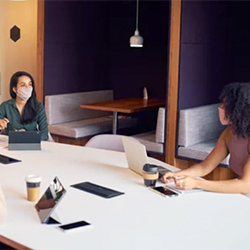By Lisa Marshall
The mitigation measures that changed people’s behavior until a vaccine could be developed prevented roughly 800,000 COVID-19 U.S. deaths, far more than many scientists predicted was possible, according to new University of Colorado Boulder and UCLA research.

However, the researchers stressed that interventions like sequester in place and school closures came at a great cost—one that could be reduced in future pandemics if the country had a better infrastructure for gathering public health data.
The paper was published in the spring edition of Brookings Papers on Economic Activity (2024 Mar 27).
“Our work shows that behavior change can be a powerful force for slowing the spread of a dangerous and infectious respiratory disease for a long time,” said co-author Stephen Kissler, PhD, MS, an assistant professor of computer science at CU Boulder. “But with COVID-19, it came at a tremendous economic, social and human cost.”
For the study, Dr. Kissler, a mathematical epidemiologist, teamed up with Andrew Atkeson, PhD, a professor of economics at UCLA, to find out how many deaths from COVID-19 were prevented by behavioral interventions like masking and social distancing, combined with vaccines?
The researchers gathered national serology data from blood samples to estimate how many people had been infected or vaccinated at various points from February 2020 to February 2024 and mortality data from the CDC.
Then, they used computer models to mathematically recreate the pandemic as it happened, factoring in the role of behavioral changes.
By tinkering with the model inputs to simulate different scenarios, they were able to ask questions: How many people would have died if no one had done things like wear masks or practice social distancing? Or how many people would have died if the vaccines never came?
The study found that vaccines and behavioral changes were inextricably linked.
“Without vaccines, behavior alone would have postponed infections, but in the end, nearly everyone would have been infected and subject to a high infection fatality rate from that first infection,” they wrote. “Without a behavioral response, vaccines would have come too late to save lives.”
They found that, thanks largely to behavioral changes, 68% of Americans were able to get vaccinated before being infected.
Had they gotten COVID-19 for the first time without being vaccinated, their risk of dying would have been as much as four times higher.
Without the two-pronged strategy, 1.98 million people in the United States would have died of COVID-19 in the last four years versus the 1.18 million who succumbed to the disease. The pandemic would have ripped through the country in the first eight months, taking 60,000 lives per day at its peak.
The researchers estimated that the slowdown in vaccine uptake during the second half of 2021, as the virus mutated, cost an additional 273,000 preventable deaths from the delta and omicron variants.
Drs. Kissler and Atkeson were surprised at how big an impact behavior changes had, as pre-pandemic studies forecasted their impact would be minimal.
One study found that behavioral interventions reduced transmission by less than 50% during the 1918 influenza epidemic, and people only changed their behavior for about 15 weeks. Another study forecasted that if a pandemic hit the United States, and vaccines came more than 120 days after the first case, they would essentially be useless because most people would have already been infected.
Only 1 in 5 Americans (and a much smaller proportion of people >65 years of age) had been infected by the time COVID-19 vaccines were made available, 11 months after the first case.
“As an epidemiologist at the beginning of the pandemic, I certainly did not think that we could have kept it up for as long as we needed to in order to avert as many deaths as we did,” Dr. Kissler said.
That said, the authors worry that if another pandemic were to emerge, Americans would be less willing to stay at home.
“My concern is that the next pandemic will be deadlier, but people will ignore it because they will say, ‘Oh, we overdid it during COVID,’” Dr. Atkeson said.
He and Dr. Kissler acknowledge that some behavioral changes made during COVID-19, such as requiring masks on outdoor hiking trails, ended up being unnecessary, but knowledge about transmission was still lacking.
They said U.S. policymakers should prioritize developing a more centralized national infrastructure for gathering data on how people move around and interact to spread viruses and what behaviors work best to contain them.
“We stumbled through [COVID-19] without a plan. We were basically flying blind,” Dr. Atkeson explained.
The researchers noted that the CDC Center for Forecasting and Outbreak Analytics is already working to develop a system similar to the National Weather Service to provide forecasts on the country’s epidemiological conditions.
They pointed to the recent mpox outbreak, which was contained relatively swiftly with targeted behavioral interventions and vaccines, as a great success.
“The behavioral changes needed to prevent disease spread can look very different from one community to the next and one virus to the next,” Dr. Kissler said. “If we have more granular, timely data to work with we can do a much better job of targeting interventions, so we don’t have to just stop everything.”
{RELATED-HORIZONTAL}